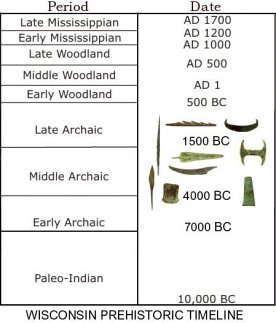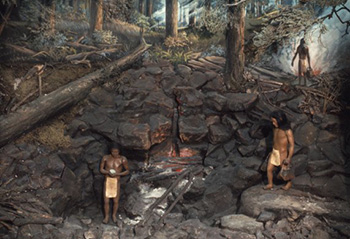Introduction
The Old Copper Complex, also known as the Old Copper Culture, refers to the items made by early inhabitants of the Great Lakes region during a period that spans several thousand years and covers several thousand square miles. The most conclusive evidence suggests that native copper was utilized to produce a wide variety of tools beginning in the Middle Archaic period circa 4,000 BC. The vast majority of this evidence comes from dense concentrations of Old Copper finds in eastern Wisconsin. These copper tools cover a broad range of artifact types: axes, adzes, various forms of projectile points, knives, perforators, fishhooks, and harpoons. By about 1,500 BC, artifact forms began to shift from utilitarian objects to personal ornaments, which may reflect an increase in social stratification toward the Late Archaic and Early Woodland period (Pleger 2000). While copper continued to be used in North America up until European contact, it was only used in small amounts, primarily for symbolic ornaments.
The Milwaukee Public Museum is fortunate to be the caretaker of one of the largest collections of Old Copper Complex artifacts in the region, totaling more than 1,500 individual pieces. This assemblage includes everything from small copper fragments to large tools such as axes and projectile points. Other institutions harboring large quantities of this material include: the Wisconsin State Historical Society in Madison, the Chicago Field Museum, the Neville Public Museum in Green Bay, the American Museum of Natural History in Washington D.C. and the Pennsylvania University Museum in Philadelphia, to name a few. Precisely what number exists in private hands can only be surmised, though in order to increase our understanding of this ancient copper tradition, it is important for these collections to be made accessible for research and publication.
At the turn of the twentieth century, Mr. P.V. Lawson of Menasha Wisconsin, compiled the most comprehensive inventory of Old Copper in the state, estimated to be at least 13,000 copper artifacts (Brown 1904:50). In the one hundred years since this initial tabulation, it is difficult to assess the total number of Old Copper artifacts so far discovered, however it quite possibly could be in range of 20,000. Evidence suggests that the total number would have been much greater if early European pioneers had not melted down this valuable metal to forge new articles of material culture (ibid).
The Archaic Period in Wisconsin

Archaeologists divide the prehistoric cultures of the Upper Midwest into four major periods (in chronological order): Paleo-Indian, Archaic, Woodland and Mississippian. Each of these periods is further subdivided, based on observable changes in technology and social organization. Beginning around 9,000 years ago, changes in technology and subsistence strategies mark the transition from the Paleo-Indian Stage to the Archaic Stage. During this time, there was a continuation of climatic and environmental fluctuations, which led to variation in flora and fauna species in the Great Lakes region.
There are four distinctive settlement types associated with the Archaic Stage. The first and most visible types of sites are Base Camps, which have either annual or seasonal occupation. The second site-type are Special Purpose Sites, i.e. hunting/collecting camps. These were occupied for a short period of time and little material evidence remains from these type of sites. The third type are Quarry Sites, where the main focus is processing raw materials, such as lithics or copper. The fourth type of Archaic Period sites are Mortuary or burial sites, where distinctive sacred areas were selected and rituals performed.
Despite the development of the Archaic Tradition throughout the Upper Midwest being sporadic and uneven, the period can be defined by three main unifying characteristics: 1) Subsistence is based upon hunting of diverse small game species and collecting a variety of wild plant species, 2) There is no pottery in the Archaic Tradition, 3) Burials occur in natural knolls or flat cemeteries, but not in man-made burial mounds (Stoltman 1986:207). The Middle Archaic Period begins around 6,000 years ago based on the innovation of several distinctive artifact types. It was during this period that the Old Copper Complex began to heavily utilize native copper for the production of utilitarian items such as knives, projectile points, woodworking tools, perforators and ornaments.
Historic Interpretation of Old Copper
During the 19th and early 20th centuries, the prevailing theories of Old Copper production in Wisconsin reflected the social climate of the period, which was rooted in both naiveté and racism. The popular belief was that this sophisticated technology could not have been the product of the indigenous tribes who occupied the Great Lakes region before European settlement. Previous theories claimed that Bronze Age peoples from Europe made their way to Lake Superior to supply the demand for copper across the Atlantic Ocean. Other dubious theories attributed this copper production variously to the Phoenicians, the Berbers, and the Vikings (Griffin 1961, Martin, 1999). Not surprisingly, no archaeological evidence has been found to substantiate such notions.
Increased scientific inquiry and archaeological excavations at the turn of the last century led to changed perspectives. Nevertheless, it was not until the development of radiocarbon dating in the 1950s that the first conclusive evidence of the age of the Old Copper Complex in Wisconsin was realized. These results provided conclusive evidence that aboriginal use of Great Lakes copper began during Middle Archaic times, circa 4,000 B.C
Mining and Fabrication

(Miniature Diorama of an Archaic Copper Mine, formerly at the Milwaukee Public Museum)
During the 1950s Dr. Robert E. Ritzenthaler of the Milwaukee Public Museum postulated that the origin of the Old Copper Complex "occurred when an early hunting and gathering group living in the Wisconsin area began to utilize native copper for the production of the distinctive utilitarian types of that area. At first, the nuggets in the glacial drift provided a handy source; later, copper was quarried from the trap rocks of Isle Royale and the Keweenaw Peninsula" along the south shore of Lake Superior in the Upper Peninsula of Michigan (Ritzenthaler 1957:323).
There has been little dispute over the last century that the primary copper sources that were exploited by the Old Copper Complex manufactures came from natural ore deposits spanning 120 miles along the southern shores of Lake Superior on the Keweenaw Peninsula. This native metal has an exceptional ratio of pure copper, typically over 95%. The most heavily utilized mines were discovered at Isle Royale, Keweenaw and Ontonagon. The following is an excerpt from the turn of the last century by Mr. J.T. Reeder of the Tamarack Mining Company in Calumet, Michigan, as he describes the ore deposits in this region.
"Around the Victoria location, the old Minnesota (now Michigan), the Rockland, the Mass and Adventure, and Winona, are hundreds of old Indian copper pits. To say that there are thousands would not be exaggerating. They extend from a few feet to as much as thirty feet into the gravel and solid rock" (Brown 1904:54).
Recent analysis of these prehistoric copper pits has generated great debate regarding the amount of copper extracted from them. Precisely what tonnage of copper was mined is difficult to determine, as no comprehensive study of the prehistoric mines has been completed. The largest estimate puts the total extracted copper ore during the Archaic period at as much as 1.5 billion pounds (Drier et. al. 1961). However, the real amount of native copper ore extracted during the prehistoric period is currently unknown (Martin 1995).
There is less contention regarding the techniques used to extract the copper from the bedrock. Thousands of grooved hammerstones have been found in and around these prehistoric mining pits, supporting the theory that a great deal of manual labor was necessary to remove the copper ore. Another useful technique likely used to extract the ore was via thermal induced shattering, in which miners would light a fire beside the desired vein of ore, thus heating the rock surface. By applying water to this hot surface it would cause the rock to shatter, allowing for easier removal of the copper ore.
Once the copper was extracted, the primary method of tool manufacture was by hammering the ore into the desired form. An additional fabrication technique was annealing, a process in which the ore was heated to a more malleable state then hammered into shape. Analysis of these artifacts exhibits obvious signs of layering, caused by hammering and folding the copper to produce the finished product. To date, there is no convincing evidence that archaic populations of the Old Copper Complex smelted copper to pour into pre-made moulds (Martin 1999). Indeed, many copper artifacts show extreme uniformity and quality, indicating a high degree of technological specialization. This has led to speculation that Old Copper Complex artisans did in fact reach the level of smelting copper ore (Neiburger 1984). Exactly where these centers of innovation were located is so far poorly understood; yet the distribution of Old Copper finds across the landscape provides some indication of where the core Copper Complex areas were concentrated.
Web page produced by University of Wisconsin-Milwaukee Anthropology and Museum Studies graduate student, Kevin M. Cullen in 2006
Questions? Contact Dawn Scher Thomae

